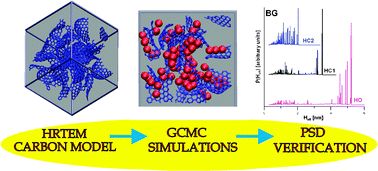How realistic is the pore size distribution calculated from adsorption isotherms if activated carbon is composed of fullerene-like fragments?†
Abstract
A plausible model for the structure of non-graphitizing carbon is one which consists of curved,

* Corresponding authors
a
N. Copernicus University, Department of Chemistry, Physicochemistry of Carbon Materials Research Group, Gagarin St. 7, Toruń, Poland
E-mail:
aterzyk@chem.uni.torun.pl
Web: http://www.chem.uni.torun.pl/%E2%88%BCaterzyk/
Fax: +48 (0)56 654 24 77
Tel: +48 (0)56 611 43 71
b Centre for Advanced Microscopy, University of Reading, Whiteknights, Reading, UK
c N. Copernicus University, Department of Chemistry, Synthesis and Modification of Carbon Materials Research Group, Gagarin St. 7, Toruń, Poland
d Division of Chemical Engineering, The University of Queensland, Brisbane, Australia
A plausible model for the structure of non-graphitizing carbon is one which consists of curved,

 Please wait while we load your content...
Something went wrong. Try again?
Please wait while we load your content...
Something went wrong. Try again?
A. P. Terzyk, S. Furmaniak, P. J. F. Harris, P. A. Gauden, J. Włoch, P. Kowalczyk and G. Rychlicki, Phys. Chem. Chem. Phys., 2007, 9, 5919 DOI: 10.1039/B710552E
To request permission to reproduce material from this article, please go to the Copyright Clearance Center request page.
If you are an author contributing to an RSC publication, you do not need to request permission provided correct acknowledgement is given.
If you are the author of this article, you do not need to request permission to reproduce figures and diagrams provided correct acknowledgement is given. If you want to reproduce the whole article in a third-party publication (excluding your thesis/dissertation for which permission is not required) please go to the Copyright Clearance Center request page.
Read more about how to correctly acknowledge RSC content.
 Fetching data from CrossRef.
Fetching data from CrossRef.
This may take some time to load.
Loading related content
